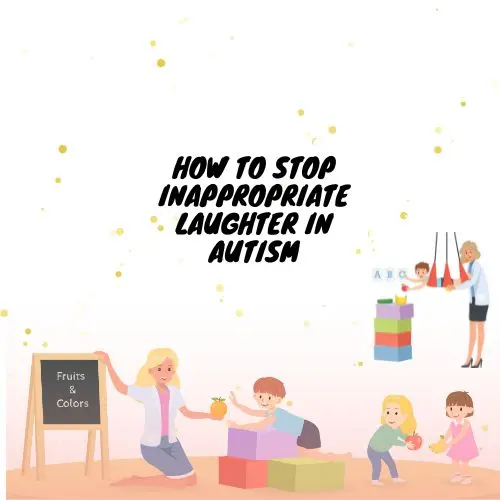Introduction
Inappropriate laughter is a common symptom of autism spectrum disorder (ASD). While laughter is normally a positive form of communication, excessive or improper laughter can be disruptive and socially isolating for autistic individuals. This comprehensive guide provides parents, caregivers, and educators with techniques to help autistic children and adults learn to control inappropriate laughter.
Understanding Inappropriate Laughter in Autism
Inappropriate laughter in autism often stems from difficulties regulating emotions or communicating in a neurotypical way. Some key facts about inappropriate laughter in ASD:
- Affects up to 80% of autistic individuals
- Usually starts in early childhood
- This can occur in the absence of humor or positive emotions
- Maybe it is a sign of anxiety, discomfort, or sensory overload
- Laughter may seem exaggerated, excessive, or “out of sync.”
While the intention is not to eliminate laughter, the goal is to help autistic individuals laugh more appropriately in social settings. With compassion and consistency, inappropriate laughter can be reduced significantly.
Step 1: Identify Triggers for Inappropriate Laughter

The first step is observing and recording your child’s laughter episodes to identify patterns. Take note of:
- When laughter happens: Time of day, location, activity
- Triggers: Certain words, sensations, situations
- Frequency & duration
- What precedes and follows each episode
Look for correlations between inappropriate laughter and potential triggers like stress, transitions, boredom, or overstimulation. This data will help you implement strategies for your child’s specific needs.
Step 2: Teach Replacement Behaviors

Instead of just eliminating the unwanted behavior, teach alternative appropriate responses. Useful replacements include:
- Smiling instead of laughing
- Substituting a short “hehe” for excessive laughter
- Redirecting laughter energy into deep breaths
- Asking for a break if overstimulated
Role-play scenarios that commonly trigger laughter and rehearse using these appropriate reactions. Offer praise and rewards when these replacement skills are used successfully.
Step 3: Adjust the Environment

Look for aspects of the physical or social environment that may contribute to inappropriate laughter episodes. Ways to adjust the environment include:
- Eliminating overstimulating sights, sounds, smells
- Using noise-canceling headphones to minimize input
- Adding sensory tools like fidget toys or chewy necklaces
- Creating “quiet zones” for relaxation during stressful times
- Giving warning before transitions
- Explaining social situations explicitly, like sarcasm or metaphor
- Teaching self-regulation techniques like deep pressure or counting
A more autism-friendly environment removes triggers and makes socially appropriate behavior easier.
Step 4: Use Visual Supports
Visual aids provide concrete reminders to use appropriate laughter. Post cue cards with helpful visuals around your home or classroom. Useful images include:
- A finger over smiling lips as a “quiet laughter” reminder
- A stop sign when laughter is not okay
- A checklist showing replacement behaviors
- A thermometer showing levels of stimulation
- A visualization of taking deep breaths
Visual supports capitalize on autistic optical learning strengths. With consistent use, they can swiftly prompt appropriate reactions.
Step 5: Practice Social Skills
Build social awareness and empathy through games and exercises. Helpful activities include:
- “Perspective taking” exercises imagining how others feel
- Reading stories and discussing the feelings of characters
- Role-playing appropriate vs. inappropriate laughter
- Practicing reading facial expressions and body language
- Learning about idioms, sarcasm, and tone of voice
- Playing cooperative games rather than competitive
Improved social communication skills help autistic individuals manage laughter in social situations. Focus on building empathy, self-awareness, and reciprocity.
Step 6: Use Behavioral Interventions
While punishment is ineffective, redirecting behavior in real time can be constructive. Tactics include:
- Gentle reminders to use replacement skills
- Saying “Quiet laughter, please” or “Inside laughter.”
- Redirecting focus to a new activity or fidget item
- Providing sensory input like a tight hug or deep pressure
- Giving a choice between appropriate options
- Withdrawing attention for 30-60 seconds when laughter continues
Stay patient, calm, and consistent. Prevent destructive behavior before it starts rather than reacting to inappropriate laughter afterward.
Step 7: Seek Professional Help if Needed

If laughter remains disruptive despite consistent efforts, consult a qualified professional. They can assess whether:
- Mental health issues like anxiety require treatment
- Medication may help in some cases
- Specialized therapies could benefit social or regulation skills
- Testing is needed to rule out medical causes
Working with experts ensures you’re addressing the root causes comprehensively. Don’t hesitate to ask for support.
Conclusion: Stay Positive
With repetition and compassion, inappropriate laughter can be reduced step by step. While not every strategy may help, stick with a consistent approach. Celebrate every success and focus on enabling more socially appropriate, enjoyable laughter that aligns with inner feelings. Laughter is contagious, so your child will often follow if you model appropriate laughter!


1 thought on “How to Stop Inappropriate Laughter in Autism: A Step-by-Step Guide”